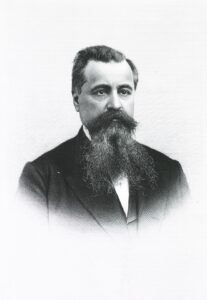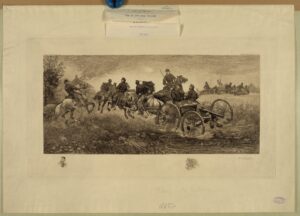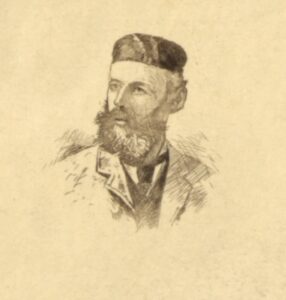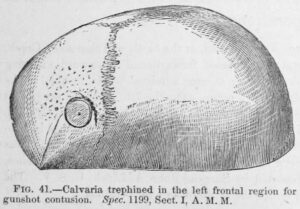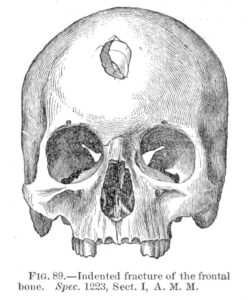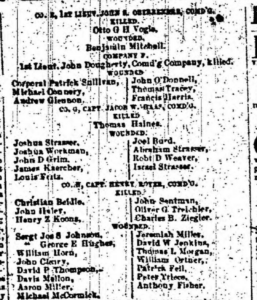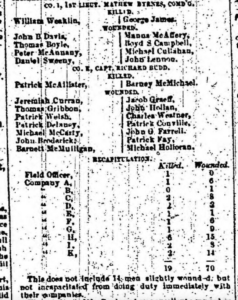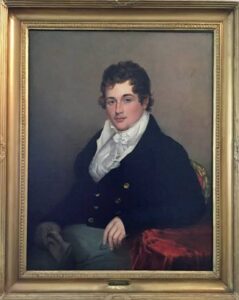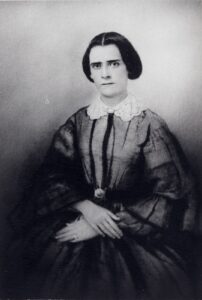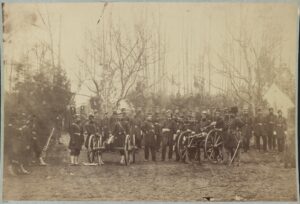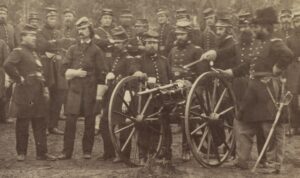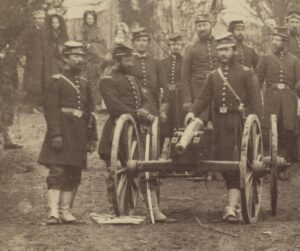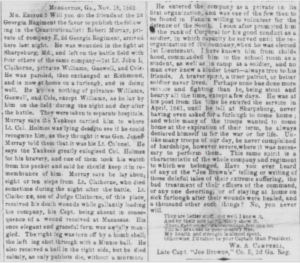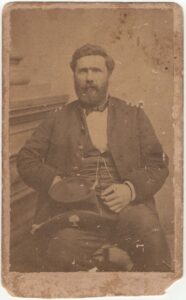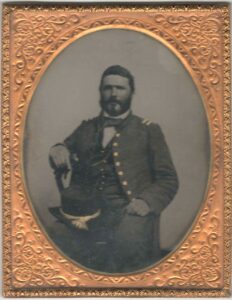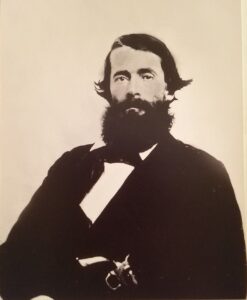Dr. Charles Squire Wood (c. 1877)
21 October 2024
This excellent portrait, from a steel plate engraving, is of Connecticut-born physician Charles Squire Wood, who was Assistant Surgeon of the 66th New York Infantry and treated wounded soldiers on the field after Antietam in September 1862.
This copy is from the Images from the History of Medicine (IHM) collection at the National Library of Medicine. There’s one for sale on eBay, if you hurry.
Going into Action (1887)
26 September 2024
This evocative piece is from an etching by New York artist William Henry Shelton (1840-1932). He depicted horse artillery troops at Chancellorsville in May 1863, and had a run of 750 copies printed by Bryan, Taylor & Company in New York City in 1887.
He deposited this copy with the Library of Congress in September 1877 to protect his copyright (touch to enlarge).
Shelton was himself an artilleryman – a Private in a New York battery at Antietam and Chancellorsville, later First Sergeant, 2nd Lieutenant, and lastly First Lieutenant near the end of the war – so he had some idea about the subject matter.
Here he is in enlisted uniform.
Two intriguing details about this particular print of Going into Action are the small sketches William made in the margin below the main picture. At the left, a self-portrait of the artist, and on the right, a horse head.
Notes
This print is still in the collection of the Library of Congress, and is now online.
His wartime photograph hosted by William “Griff” Griffing on Spared & Shared accompanying a Shelton letter of 19 October 1862.
Calvaria trephined in the left frontal region (1862)
15 September 2024
I’ve gone to Army Surgeon-General Joseph K Barnes’ Medical and Surgical History of the War of the Rebellion (1870-1883) many times over the years chasing Antietam casualties, but never done a systematic scrub through it. I’m underway on that now.
Among the first cases I found was that of Private Samuel Altman of the 50th Georgia Infantry, who was wounded by a gunshot to his head at Fox’s Gap on South Mountain on 14 September 1862. He was captured there and treated by US Army surgeons on the field and in hospitals in Frederick, MD and Philadelphia, PA. Despite their efforts, including trephining – boring a hole in his skull to relive pressure – he succumbed to the effects of his wound on 11 October 1862.
Here’s an illustration of part of his skull, post-mortem, which was kept in the collection of the Army Medical Museum as an aid to education of future combat surgeons.
A little later in that volume I found the fine illustration below, purported by Surgeon Bernard A Vanderkieft to be the skull of an unnamed Confederate sharpshooter knocked from a tree atop South Mountain at long range by Union skirmishers, presumably on 14 September 1862. Touch the image to read the accompanying text.
Notes
A fine presentation of all 6 volumes of the MSHWR is online from the National Library of Medicine.
Altman’s skull is found in Volume 2, Part 1 on page 123. The sharpshooter’s is on page 170.
Crampton’s Gap casualty list, 96th Pennsylvania Infantry
31 August 2024
Appended to Colonel Cake’s official report as printed on page 2 of the Pottsville (PA) Miner’s Journal of Saturday, 4 October 1862, is his list of the men of his 96th Pennsylvania Infantry who were killed or wounded in the fight at Crampton’s Gap on South Mountain on 14 September 1862. It’s not found in the Official Records in company with the Colonel’s report.
My transcription of the text and links to the individual soldiers’ pages on AotW, after the jump …
Lt Evan Morrison Woodward (c. 1862)
28 August 2024
A 34 year old clerk from Philadelphia, Morrison Woodward was Sergeant Major of the 2nd Pennsylvania Reserves when they fought in the Maryland Campaign of September 1862.
He wrote of his experiences there in his 1865 regimental history, describing the scene at Turner’s Gap on the 14th and the terrible fighting on the evening of the 16th and morning of the 17th at Antietam. He also included this almost comic incident:
When we broke and were driven across the field, a chicken was scared up, which displayed equal alacrity with the men in its flight to the rear, and a most animated race for life or death took place between them, but the Sergeant-major seizing a favorable opportunity threw himself upon the ground and captured the prize, which furnished a most sumptuous repast.
He was appointed First Lieutenant and Regimental Adjutant after the battle and (much) later was award the Medal of Honor for his work in capturing enemy troops and their flag at Fredericksburg that December.
Morrison’s father James Searles Woodward (November 1790-October 1862) was a prosperous merchant in Philadelphia. Just for fun, here’s his c.1820 portrait as a young man, now in the Naomi Wood Collection, hanging in the dining room of the Woodford Mansion, Philadelphia.
Notes
Evan Morrison Woodward’s photograph, which looks to have been hand-retouched, was sold by the Union Drummer Boy in Gettysburg.
Woodward’s history of the 2nd Reserves – Our Campaigns or, The Marches, Bivouacs, Battles, Incidents of Camp Life and History of our Regiment during its Three Years Term of Service – is online from the Internet Archive.
Colonel H.L. Cake of the 96th Pennsylvania Infantry, in reporting his regiment’s part in the combat at Crampton’s Gap on 14 September 1862, included this detail:
It was a most exhausting charge. By the time we had ascended half way the cannon had ceased firing on our left, and the enemy seldom replied to our fire with their muskets. We made captures at every step. After passing the crest of the mountain a lieutenant [which?] of the Fifteenth North Carolina delivered himself up, I sent during the charge, 42 prisoners to the rear, including the captain of Company G, Sixteenth Georgia, wounded, and other officers and men most of them unhurt.
That Georgia Captain was Augustus C Thompson, of Jackson County, who had been shot in the left thigh before he was captured. He survived, but was disabled for further service and went home.
This superb photograph of him was donated to the Library of Congress by Tom Liljenquist in 2012. I’d guess it was taken as he first entered service in July 1861.
While looking further into Captain Thompson today I found that picture of his wife, Mary Arline Randolph, shared to the Mormon genealogical database by Julie Kinkaid in 2022. I do not know when it was taken, but she looks very young – in her twenties, perhaps? She was 17 when she married 22 year old Augustus in 1850.
They had a daughter, Nancy, and both lived into their 70s, for the last 20 years in Lakeland, FL, where Augustus ran the county poor house. Mary Arline only outlived him by about 8 months.
Officers of the 96th Pennsylvania Infantry (1861)
4 August 2024
This lovely image was probably taken at the home of the 96th Pennsylvania Volunteers, Camp Northumberland, near Alexandria, VA between December 1861 and March 1862. These, then, are the officers of the regiment at that time and place.
Particularly interesting are the two wheeled weapons at the front of the group.
On the right is a Union Repeating Gun (also known as an Ager Gun or the coffee mill gun). A few of these hand-cranked repeating guns were produced in 1861; apparently President Lincoln was intrigued by their potential and had 10 built. As many as 50 others where produced later. They saw very limited use during the war, and I’ve seen no mention of this one’s actual use by the 96th.
Gathered around that gun are the field and some of the staff officers of the regiment.
In the foreground to our right, left hand on hip, wearing a plumed Hardee hat, is Colonel Henry Lutz Cake, organizer and commander of the regiment. He was an excellent combat leader, which was particularly apparent in action at Crampton’s Gap on 14 September 1862.
Next to him is Lieutenant Colonel Jacob Gellert Frick, a Mexican War veteran. By Antietam in September 1862 he was Colonel of his own regiment, the 129th Pennsylvania. He was later awarded the Medal of Honor for his work at Fredericksburg and Chancellorsville.
To Frick’s right is the Chaplain, the Reverend Samuel Fisher Colt (1817-1893), pastor of the Presbyterian Church in Pottsville. He was discharged in July 1862 and was not on the Maryland Campaign.
Next along to our left is Major Lewis J Martin, a coal mining engineer from Pottsville. He was mortally wounded by a gunshot to his head at Crampton’s Gap and died soon after.
I have not positively identified the next 4 men, but the man with his hand on the wheel may be Dr. Daniel Webster Bland, who was the regiment’s Surgeon from organization to muster out, in October 1864, and later Sixth Army Corps Medical Inspector. I have not confirmed his presence in Maryland in 1862.
The tall man second from left with the luxuriant mustache is probably Assistant Surgeon Washington George Nugent. He had prior service in the 3-month 14th Pennsylvania. He resigned from the 96th on 12 September 1862 to accept appointment as the Surgeon of the 9-month 126th Pennsylvania Infantry, afterward as Surgeon of the 20th Regiment, Emergency Militia of 1863, and then was a contract surgeon at the Fort Delaware post & prison hospital to the end of the war.
The artillery piece in that picture is part of a fascinating story dating to the early organization of the 96th Pennsylvania in September 1861.
A group of Pottsville First Defender veterans, members of the Good Intent Fire Company, formed the Good Intent Light Artillery under Captain Lessig.
The battery … was to be short lived, that is as far as the name was concerned. The members were unable to secure any ordnance to drill with and finally the “boys” decided to swipe brass and make a cannon themselves. Piece by piece they scraped together the brass while some poor, unsuspecting victim scratched his head and wondered at the mysterious disappearance of some article of brass from his shop or household. When enough had been secured the brass was melted and molded into a fine cannon by Geo. W. Snyder …
The Good Intent Battery would undoubtedly have become famous, as the members did, but for an unlooked for occurrence. The 96th regiment had been recruited and lacked but one company. The Good Intent Battery was mustered into this regiment and the members then became infantrymen and “shouldered the cannon” as they remarked for ever afterward. The precious cannon was taken along with the 96th Regt., but was finally turned over to a New England Battery [June 1862], and that was the last seen or heard of it.
Those would-be artillerists became Company C of the 96th, and their officers are seen here around “their” cannon. From left to right, in the foreground, they are:
First Lieutenant Isaac E Severn. He’d served as a Private and Corporal in the Washington Artillery, which became Company H of the 25th Pennsylvania Infantry, from April to July 1861. I can’t specifically place Severn on the Maryland Campaign of 1862, though he may well have been present. He was promoted to Captain of his Company in November 1862 and mustered out with them in October 1864.
Captain William Henry Lessig, later Major, Lieutenant Colonel, and finally Colonel of the 96th Pennsylvania Infantry.
And, I think, 2nd Lieutenant Samuel Rex Russel, with his hand on the breech. He was promoted to Captain of Company H in May 1863, and served out his term to October 1864.
Notes
The photograph of the officers of the 96th is in the collection of the Library of Congress.
The quote above about the Good Intent Light Artillery is from a veteran of the unit in the Pottsville Daily Republican of 18 April 1900, found in a fantastic blog post by Stu Richards.
Big thanks to intrepid researcher Laura Elliott for finding and sharing the following clipping from the Augusta, GA Weekly Constitutionalist of 3 December 1862. She also posted it (and a transcription) to the Civil War Talk discussion group.
The primary subject of the letter quoted here was First Lieutenant John L. Claiborne, who was in command of Company E, 2nd Georgia Infantry when he was mortally wounded at Sharpsburg on 17 September 1862. He died sometime during the night after the battle.
Here’s what I’ve found about the other named individuals:
The letter’s author, William A Campbell, was born about 1830 in North Carolina and in 1860 was a married 30 year old attorney of modest means with 3 children living in Morganton, GA. He enrolled on 26 April 1861 as the original Captain of the “Joe Browns” – Company E of the 2nd Georgia Infantry. He was ill in the first months of 1862 and retired or was dropped on 28 April 1862 during the Army reorganization, perhaps then on sick furlough, and probably because he was not reelected Captain. He requested duty in Georgia as an enrolling officer in May 1862, but does not appear to have been appointed. He died in Morganton in 1864.
Battle witness Robert F Murray (wounded and captured at Sharpsburg) was wounded again and disabled for further field service in the Wilderness in 1864 but survived to be paroled in North Carolina in May 1865. I found no further information about him.
Corporal P.K. (or D.K.) Williams died of his wounds in a US Army hospital in Frederick, MD on 21 April 1863. He was then 28 years old. The only available military records for him are from US Army medical files created after Antietam.
Private George W. Gosnell [Gaswell] died of wounds at the Locust Spring field hospital on the Geeting farm near Keedysville, MD on 6 October 1862.
Private William M. Cole survived the war to be surrendered at Appomattox Court House, VA on 9 April 1865. I found no further information about him.
Major James H Dingle, Hampton Legion Infantry (1862)
30 June 2024
Going by Hervey, and sometimes seen as Junior, probably after his grandfather, James Hervey Dingle of the Clarendon District of South Carolina was the 38 year old Major of the Hampton Legion when he was killed at Sharpsburg on 17 September 1862. The Legion was part of General John Bell Hood’s Division and was engaged in ferocious combat in and near Miller’s Cornfield that morning [map].
The shoulder bars on his coat are a bit unusual, but probably represent the rank of First Lieutenant, which he held from 25 April to 20 June 1862, before his appointment to Major.
These photographs were graciously shared by descendant Jeff Dingle, who owns the originals.
William T Gregory (c. 1862)
14 June 2024
As a member of Florida’s Secession Convention of January 1861, wealthy planter William Thomas Gregory voted against leaving the Union, but about a year later he enrolled as a Captain in the 5th Florida Infantry for Confederate Service. He gave his life to that cause, being mortally wounded at Sharpsburg on 17 September 1862.
Great-great-great-grandson Russell Suber kindly sent me a copy of his fine photograph of a fierce looking Captain Gregory.
